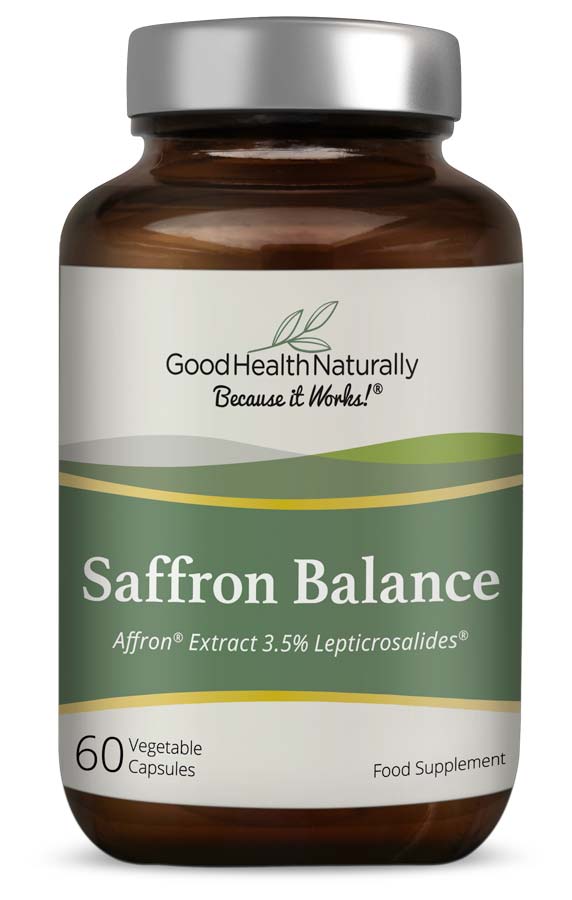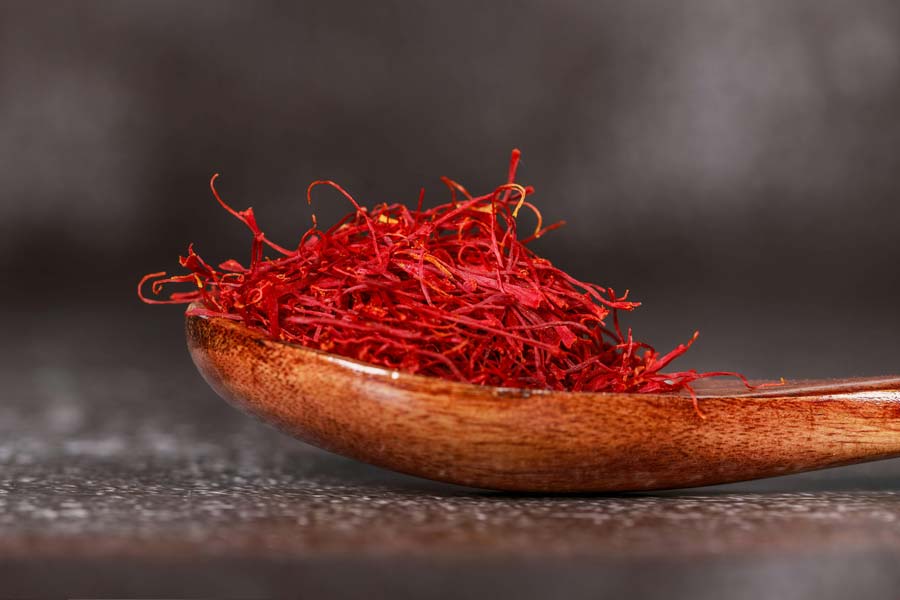Saffron, the vivid red spice harvested from the delicate stigmas of the Crocus sativus flower, has fascinated cultures for millennia. Prized for its colour, flavour, and rarity, saffron is one of the most expensive spices in the world — sometimes even described as “red gold.” Beyond its culinary appeal, saffron has long been used as a natural remedy, and modern science is now confirming many of its traditional uses.
From emotional wellbeing and hormonal balance to better sleep and vision support, saffron is stepping into the spotlight as a natural aid for mind and body. This article explores the history of saffron, its active compounds, and the growing body of research into saffron health benefits.
A Rich History: Saffron Through the Ages
Saffron’s story stretches back thousands of years. Ancient frescoes found on the Greek island of Santorini depict saffron gatherers as early as 1600 BC, highlighting its cultural importance. In Persia, saffron was woven into carpets, dissolved in teas, and offered in rituals. Cleopatra is said to have bathed in saffron-infused water for its cosmetic and aphrodisiac qualities.
In Ayurvedic medicine, saffron was believed to balance the body’s three doshas and was prescribed for digestive complaints, mood disorders, and women’s health. Traditional Chinese Medicine (TCM) used saffron to “invigorate the blood” and support menstrual health. Roman physicians employed it for wound healing, while medieval European monks used saffron to colour manuscripts and as part of herbal remedies for melancholy.
Its high value meant saffron was often guarded and traded carefully. In 14th-century Europe, saffron was worth more than gold by weight, and laws were introduced to prevent adulteration. This historical reverence underlines saffron’s enduring role as both a luxury and a medicine.
 What Makes Saffron Special?
What Makes Saffron Special?
The therapeutic power of saffron lies in its active compounds, including:
- Crocin – gives saffron its rich red hue and acts as a potent antioxidant.
- Crocetin – helps improve blood flow and may protect against inflammation.
- Safranal – provides saffron’s distinct aroma and supports mood and sleep.
- Picrocrocin – contributes to saffron’s bitter taste and digestive benefits.
Together, these bioactive compounds help explain the wide-ranging saffron health benefits seen in both traditional use and modern science.
How Saffron Works in the Body
Research suggests that saffron influences brain chemistry and cellular function in several ways:
- Neurotransmitter balance – saffron appears to inhibit the reuptake of serotonin and dopamine, helping to support mood regulation.
- GABA activity – safranal may enhance GABA receptors in the brain, promoting relaxation and better sleep.
- Antioxidant defence – crocin helps neutralise free radicals, reducing oxidative stress that contributes to ageing and disease.
- Anti-inflammatory action – saffron compounds modulate inflammatory pathways, potentially lowering systemic inflammation.
These overlapping mechanisms provide a scientific foundation for saffron’s broad health effects.
Saffron and Mood: A Natural Antidepressant?
Perhaps the best-studied area of saffron research is its impact on mood. Clinical trials consistently demonstrate that saffron supplementation can help alleviate low mood and promote emotional balance.
- A 2017 trial found that 28mg of saffron extract daily for four weeks significantly reduced symptoms of stress, anxiety, and low mood in adults, while improving energy levels.
- A 2025 study involving 202 adults with subclinical depression reported that 28mg of saffron daily reduced depressive symptoms by 72%, compared to 54% with placebo.
- Earlier research has even shown saffron to be as effective as citalopram, a commonly prescribed antidepressant, for major depressive disorder — but with fewer side effects.
These findings make saffron a promising natural option for supporting mood, particularly for those seeking gentle, well-tolerated alternatives.
Hormonal Balance and Women’s Health
Hormonal changes can affect mood, energy, and wellbeing throughout a woman’s life. Saffron appears to help smooth these transitions.
- Premenstrual syndrome (PMS): A 2007 double-blind trial found that saffron significantly reduced symptoms of PMS, including irritability, fatigue, and pain. A 2024 review confirmed saffron’s role in easing both emotional and physical symptoms.
- Perimenopause and menopause: In a 2021 study, women taking 28mg of saffron daily for 12 weeks experienced a 33% reduction in anxiety scores and a 32% reduction in depression scores. Participants reported feeling calmer and more emotionally balanced.
This makes saffron particularly valuable as a natural aid during the hormonal transitions of PMS and menopause.
Better Sleep with Saffron
Sleep difficulties are increasingly common, especially during midlife and menopause. Saffron has been shown to help improve sleep quality.
- In a 2020 trial, adults with self-reported poor sleep took 28mg of saffron extract daily for four weeks. They experienced significant improvements in sleep quality and duration compared to placebo.
- Researchers suggest that safranal’s influence on GABA and serotonin pathways helps promote relaxation and more restful sleep.
For individuals struggling with insomnia or restless nights, saffron may offer a safe, natural alternative to over-the-counter sleep aids.
Cognitive and Eye Health
Emerging evidence also suggests that saffron may play a role in brain and eye health.
- Cognition: Preliminary studies suggest that saffron may help protect memory and cognitive function, likely due to its antioxidant and anti-inflammatory effects. This makes it an area of interest in age-related cognitive decline.
- Vision: Research has shown saffron supplementation can improve visual function in early-stage age-related macular degeneration (AMD). Crocin and crocetin help protect retinal cells from oxidative stress and improve blood flow to the eye.
Although more research is needed, these findings broaden the potential applications of saffron beyond mood and sleep.
Modern Research and Standardised Extracts
While saffron has been used for centuries, one challenge has been ensuring consistent quality and potency. Enter modern standardised extracts, such as Affron®, which guarantee a minimum of 3.5% active compounds (lepticrosalides).
Clinical trials on Affron® have demonstrated benefits for mood, PMS, menopause, and sleep at doses as low as 28–30mg per day. Using a standardised extract ensures both safety and efficacy, addressing one of the biggest limitations of traditional herbal remedies.
Safety, Dosage, and Sustainability
Saffron is generally well tolerated, with clinical studies reporting very few side effects. Typical supplemental doses range from 28–30mg daily, which is far less than the large amounts used in cooking.
Because saffron is so labour-intensive to harvest (it takes around 150,000 flowers to produce just 1kg), ensuring sustainability is vital. Ethical sourcing and the use of standardised extracts help protect both the environment and saffron-growing communities.
Incorporating Saffron Into Your Routine
There are two main ways to enjoy saffron:
- Culinary use – a pinch of saffron adds flavour and colour to dishes such as paella, risotto, and teas. While delicious, the amounts used in cooking are too small to deliver therapeutic effects.
- Supplements – standardised saffron extracts provide a reliable way to access saffron’s health benefits. Look for products that specify their extract content and clinical research backing.
Conclusion: A Precious Gift from Nature
From ancient rituals to modern clinical trials, saffron has proven itself as more than just a culinary treasure. Its ability to support mood, balance hormones, improve sleep, and even protect vision makes it one of nature’s most versatile remedies.
By choosing high-quality, standardised extracts, you can be confident in accessing saffron’s proven health benefits safely and effectively. For those navigating stress, hormonal changes, restless nights, or simply seeking to enhance wellbeing, saffron truly lives up to its reputation as the world’s most precious spice.




